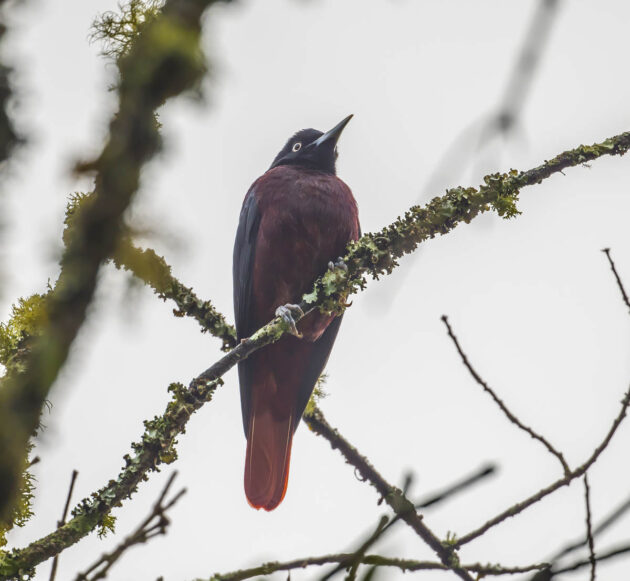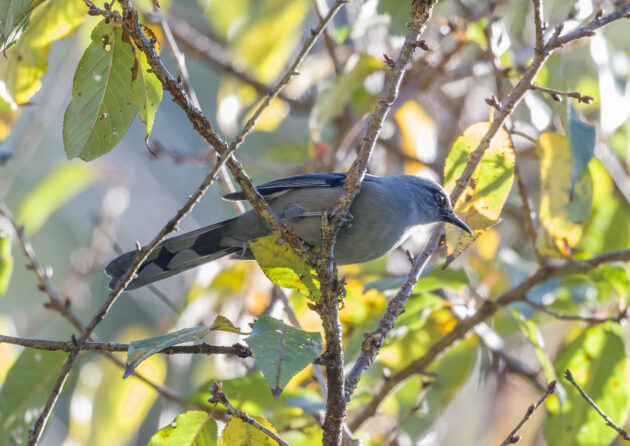Among Chinese birders, Tengchong – and particularly the monastery at the bottom of Laifengshan – is known as one of the best places to see the Slender-billed Oriole.
I do not quite get the buzz about the Slender-billed Oriole as it looks quite similar to the Black-naped Oriole and apparently is even regarded as conspecific by some authorities.

Sadly, the HBW states that the species is “almost extinct in some areas in China owing to hunting and trapping for the cagebird trade and taxidermy”.

The Maroon Oriole looks much more interesting, though my photos do not really do it full justice.

Its scientific species name traillii is a rare example of a scientist not made up by me, namely Thomas Stewart Traill (1781-1862), a Scottish doctor. According to his Wikipedia entry, he was a strong but unsuccessful supporter of women attending the university, so he is one of the better people to name a bird species after.

He should not be confused with Stewart Traill (1936–2018), the founder of a cult-like group of evangelical Christians, the Church of Bible Understanding. Given the following description of this person, he is certainly not worth naming anything after him: “More shocking was Traill’s treatment of his wife, Shirley, and his children. … on many occasions … Traill came home and immediately got out a scale for his wife to step on and be weighed. He then spanked his wife for her apparent failure to meet his expectations. … Traill did this enough times that Shirley began to hide the scale.’

The Beautiful Sibia is beautiful even in Mandarin Chinese (Li se qi mei, “Beautiful babbler”) …

… and of course in science (scientific name pulchella, “little beautiful”).

The Black Bulbul comes in two morphs – one properly black …

… and one with a white head.

As I saw both of them at the same spot in Tengchong, I wonder whether the bird below is a result of a pairing of the two morphs.

It is not necessary to leave China and go to Nepal to see the Ashy Bulbul – even though I am not sure the Chinese birds are quite as enchanting as the ones described at nepaldesk.com:

“[E]xploring Nepal’s wilderness for the enchanting Ashy Bulbul is an unforgettable experience for avid bird watchers and nature enthusiasts alike”. But I can imagine that nepaldesk says approximately the same about some amazing and enchanting leeches.

The description of the Bar-winged Flycatcher-shrike on the same site is not much less exuberant:

“While the Bar-winged Flycatcher-shrike may not rank as Nepal’s most renowned bird, its striking looks, fascinating habits, and contribution to the vibrant bird community definitely make it worth noticing.”
Contribution to the vibrant bird community. Oh my.

The poor Mountain Bulbul carries the scientific name mcclellandii, after Sir John McClelland (1805–1875) …

… even though said man mainly worked as an ichthyologist …

… apart from also being sent to north-eastern India to identify if tea could be grown there. Not sure whether he wrote to his wife about this important mission, or even if he had a wife.

It is surprising to see an Elvis imitator in Tengchong but what other ecological niche could the Crested Finchbill possibly occupy?

The Chinese name of the Chestnut-vented Nuthatch is li tun shi, with the “tun” character in the middle translated as “buttocks” by Google Translate. I always kind of suspected “vented” is a euphemism …
Witout being asked, Google Translate also adds that Li tun shi means “I opened it again” in Yoruba. Hopefully this information is useful for some readers, particularly those with plans to travel to Nigeria.

Normally I would think of these photos of a Chestnut-flanked White-eye as being pretty terrible but they do show the name-giving feature of the species reasonably well.

And – wait for it – there is a paper on the mitochondrial genome sequence of Chestnut-flanked White-eye. Welcome to 10,000 Birds, the only website in the world where such papers can be the subject of a running gag. A bad one, admittedly.

This Great Spotted Woodpecker isn’t even trying to hide its spots. But why should it.

One paper on Great Spotted Woodpeckers is titled “Requirements by the Great Spotted Woodpecker Dendrocopos major for a suburban life”, but contrary to my expectation, it does not state that the birds need a car (an SUV, perhaps?) when living in suburbia.
It seems that in this species, the males do most of the hard and the ugly work – namely hole excavation and nest sanitation (source).

Most birders probably only pay casual attention to the Korean Journal of Parasitology and will thus have missed a paper on a newly recorded feather mite on a Grey-capped Pygmy Woodpecker.

Surprisingly, the authors claim that they have no conflict of interest with this article, indicating that the international feather mite lobby is not as powerful as I thought.

According to the paper cited above, feather mites are quite host-specific, so this species of feather mites will not bother the Grey-capped Canary Flycatcher. How is that for a link?

The monastery at the bottom of Laifengshan is also a good place to see Verditer Flycatcher, at least in winter.

Good news for those who are too lazy to use Google themselves:

I finally looked up “Verditer” online.

It means (source: Oxford Languages):

“A light blue or bluish-green pigment, typically prepared by adding chalk or whiting to a solution of copper nitrate, used in making crayons and as a watercolor”.

The Blue-winged Minla has a cameo role in a paper on a bird-pollinated Himalayan plant.

Apparently, the dark color of the plant nectar attracts the bird, as shown by controlled experiments. Or in the language of the “science hippies” (Ze Frank ), the “purple nectar [acts] as a foraging signal”.

If you do not like blue, here is the Red-tailed Minla.

(To quote from “Duck Soup”, the Marx Brothers movie: “Those are my principles, and if you don’t like them… well, I have others”).

A posh-looking restaurant in a village near Tengchong has a goldfish pool installed at its entrance. I am not sure how many tourists this pool attracts, but it certainly attracts a Brown Fish Owl. From the restaurant roof, the owl presumably selects its dinner before swooping down and grabbing it without any help from the restaurant staff.

A 2004 paper looking at the conflict between another fish owl (Tawny) and cold-water fish farmers in Taiwan found that owls were an issue at a quarter of the farms observed. Sadly, at the majority of these farms, owls were trapped with steel leg-hold traps or mist nets, resulting in 10 owls being found drowned in the fish ponds. Given that the study estimates that the owls take only between 0.05% and 0.66% of the fish, the trapping seems like an overreaction, but then again, I like owls much better than fish farmers.

Source link

